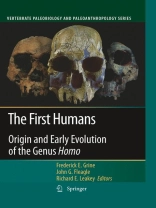There are some issues in human paleontology that seem to be timeless. Most deal with the origin and early evolution of our own genus – something about which we should care. Some of these issues pertain to taxonomy and systematics. How many species of Homo were there in the Pliocene and Pleistocene? How do we identify the earliest members the genus Homo? If there is more than one Plio-Pleistocene species, how do they relate to one another, and where and when did they evolve? Other issues relate to questions about body size, proportions and the functional adaptations of the locomotor skeleton. When did the human postcranial “Bauplan” evolve, and for what reasons? What behaviors (and what behavioral limitations) can be inferred from the postcranial bones that have been attributed to Homo habilis and Homo erectus? Still other issues relate to growth, development and life history strategies, and the biological and archeological evidence for diet and behavior in early Homo. It is often argued that dietary change played an important role in the origin and early evolution of our genus, with stone tools opening up scavenging and hunting opportunities that would have added meat protein to the diet of Homo. Still other issues relate to the environmental and climatic context in which this genus evolved.
Inhaltsverzeichnis
Retrospectives and Theoretical Perspectives.- Early Humans: Of Whom Do We Speak?.- Homo habilis—A Premature Discovery: Remembered by One of Its Founding Fathers, 42 Years Later.- Where Does the Genus Homo Begin, and How Would We Know?.- Craniodental Perspectives on Taxonomy and Systematics.- The Origin of Homo.- Comparisons of Early Pleistocene Skulls from East Africa and the Georgian Caucasus: Evidence Bearing on the Origin and Systematics of Genus Homo.- Phenetic Affinities of Plio-Pleistocene Homo Fossils from South Africa: Molar Cusp Proportions.- Postcranial Perspectives on Locomotion and Adaptation.- Evolution of the Hominin Shoulder: Early Homo.- Brains, Brawn, and the Evolution of Human Endurance Running Capabilities.- Interlimb Proportions in Humans and Fossil Hominins: Variability and Scaling.- Perspectives on Development, Diet and Behavior.- Growth and Development of the Nariokotome Youth, KNM-WT 15000.- Dental Evidence for Diets of Early Homo.- Origins and Adaptations of Early Homo: What Archeology Tells Us.- Environmental and Ecological Perspectives.- Plio-Pleistocene East African Pulsed Climate Variability and Its Influence on Early Human Evolution.- Tracking Ecological Change in Relation to the Emergence of Homo Near the Plio-Pleistocene Boundary.- Ecology of Plio-Pleistocene Mammals in the Omo—Turkana Basin and the Emergence of Homo.- Biogeochemical Evidence for the Environments of Early Homo in South Africa.- Summary Perspective on the Workshop.- The First Humans: A Summary Perspective on the Origin and Early Evolution of the Genus Homo.Über den Autor
Frederick E. GrineFred Grine is Professor of Anthropology and of Anatomical Sciences at Stony Brook University. He has published over 100 articles in scientific journals dealing with the subject of human evolution, and his work on the Late Pleistocene human fossil from Hofmeyr, South Africa, was named by Time Magazine as one of the top ten science stories of 2007. He edited Evolutionary History of the ‘Robust’ Australopithecines (1988, Aldine de Gruyter), and is author of Regional Human Anatomy: a Laboratory Workbook (2002, 2005, 2007, Mc Graw-Hill).
John G. Fleagle
John Fleagle is Distinguished Professor of Anatomical Sciences at Stony Brook University. He has conducted paleontological field work in many parts of the world, including Argentina, Egypt, Kenya, Ethiopia and India. He is the author of the textbook Primate Adaptation and Evolution (1988, 1999, Elsevier), co-editor of the Human Evolution Sourcebook (1993, 2006, Prentice Hall), and editor of the journal Evolutionary Anthropology.
Richard E. Leakey
Richard Leakey is Professor of Anthropology at Stony Brook University and former Director of the Kenya National Museums and the Kenya Wildlife Service. His field work around Lake Turkana, Kenya, has yielded a treasure trove of hominin fossils that has provided much of the paleontological record on which our understanding of human evolution is based. He has authored a number of books, including Origins, and most recently, The Sixth Extinction: Patterns of Life and The Future of Humankind. He is Chairman of the Board of the Turkana Basin Institute at Stony Brook University.
Sprache Englisch ● Format PDF ● Seiten 220 ● ISBN 9781402099809 ● Dateigröße 9.7 MB ● Herausgeber Frederick E. Grine & John G Fleagle ● Verlag Springer Netherland ● Ort Dordrecht ● Land NL ● Erscheinungsjahr 2009 ● herunterladbar 24 Monate ● Währung EUR ● ID 2149256 ● Kopierschutz Soziales DRM









